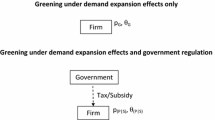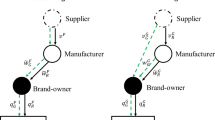Abstract
This paper studies the impact of environmental policies when firms can adjust product design as they see fit. In particular, it considers cross relationships between product design dimensions. For example, when products are designed to be more durable, this may add production steps and increase pollutant emissions during production. More generally, changes applied to one dimension can affect the cost or environmental performance of other dimensions. In this theoretical model, a firm interacts with consumers and a regulator. Before the production stage, the firm must choose the levels of three design dimensions: (1) energy performance during production, (2) energy performance during use, and (3) durability. Depending on the assumptions, the dimensions are said to be complementary, neutral, or competitive. The regulator can promote greener designs by applying targeted environmental taxes on emissions during production or consumption. The main results shed light on the consequences of modifying public policies. When some design dimensions are competitive, a targeted emission tax can result in environmental burden shifting, with an overall increase in pollution. This paper also explores the social optimum and the development of second-best policies when some policy instruments are imperfect. When the social planner ignores the possibility for firms to adjust the level of durability, firms may use planned obsolescence to mitigate the cost of too stringent environmental policies. Also, under particular conditions, a government would want to regulate and constrain the level of durability.
Similar content being viewed by others
Notes
For example, the Clean Air Act (1970) deals with air pollutants, the Montreal Protocol (1989) with substances that deplete the ozone layer, and the Kyoto Protocol (2005) with greenhouse gas emissions. On the other hand, the End of Life Vehicles (2000) and the Waste of electrical and electronic equipment (2003) directives both target end-of-life management.
In particular, quality \(q_{1}\) can be interpreted as (the combination of) any dimension for which the environmental impact occurs only once during the product lifetime, e.g., raw material extraction or waste and end-of-life treatment.
One can use for instance \(e_{i}(q_{i,t})=e_{i}^{0}-q_{i,t}\), with \( e_{i}^{0}>0\), given. The environmental qualities \(q_{1}\) and \(q_{2}\) are scaled in terms of their environmental impact. Consequently, \(c_{q_{i}}\) represents the cost of reducing pollution damage \(e_{i}(q_{i})\) from one unit.
These assumptions allow us to focus the analysis on design choices and the corresponding pollutant emissions per unit of good. This avoids the time inconsistency problem, where firms, in subsequent periods, overproduce while ignoring the rental value of previously sold goods (see, e.g., Coase 1972 or Bulow 1986). In an argument à la Bagnoli et al. (1989), our representative household is, in fact, a finite market size and time inconsistency does not hold. Bulow (1986) suggested that the monopolist could overcome the time inconsistency problem and increase profits by renting the good instead of selling it. By assumption, we have that the monopolist will indifferently sell or rent the good.
\(\tau _{2}\) can be considered as a tax on gas or energy.
Section 5.1.1 discusses the case where the monopolist only captures part of the surplus.
Appendix A presents simulations where these conditions are respected for the given values of the parameters.
We use \(\left[ \begin{array}{ccc} H_{11} &{} H_{12} &{} H_{13} \\ H_{12} &{} H_{22} &{} H_{23} \\ H_{13} &{} H_{23} &{} H_{33} \end{array} \right] =\left[ \begin{array}{lll} h_{22}h_{33}-h_{23}^{2} &{} h_{13}h_{23}-h_{12}h_{33} &{} h_{12}h_{23}-h_{13}h_{22} \\ h_{13}h_{23}-h_{12}h_{33} &{} h_{11}h_{33}-h_{13}^{2} &{} h_{13}h_{12}-h_{11}h_{23} \\ h_{12}h_{23}-h_{13}h_{22} &{} h_{13}h_{12}-h_{11}h_{23} &{} h_{11}h_{22}-h_{12}^{2}\end{array} \right] \).
The dominant-diagonal condition states that the direct effects on one dimension are larger than all the indirect effects. The diagonal (\( h_{11} \), \(h_{22}\), \(h_{33}\)) has the largest elements.
Using the methodology in Sect. 4, \(h_{23}\) in matrix (6) becomes \(h_{23}=\theta \beta (p_{e}+\tau _{2})-c_{q_{2}\delta }\). We obtain that a greater ability to capture the consumer’s WTP \(\theta \) always induces the firm to improve the environmental quality during consumption: \(d \widehat{q}_{2}^{\theta }/d\theta >0\).
The above procedure, which takes the three dimensions at their steady state values [ref.: Eqs. (2)–(4)], ignores the adjustment path of the economy. As argued in Runkel (2004b) p. 42, the following set of results can be interpreted as an approximation for the exact results that would be obtained if the impacts of taxes were applied on the time path of design choices. Virtually, the social planner chooses among a basket of steady state scenarios, and hence proposes time invariant tax rates.
The law on planned obsolescence (France 2015) is a recent example of a regulation for \(\delta \).
References
Bagnoli M, Salant SW, Swierzbinski JE (1989) Durable-goods monopoly with discrete demand. J Polit Econ 97(6):1459–1478
Bernard S (2011) Remanufacturing. J Environ Econ Manag 62:337–351
Bernard S (2015) North-South trade in reusable goods: green design meets illegal shipments of waste. J Environ Econ Manag 69:22–35
Bulow J (1986) An economic theory of planned obsolescence. Q J Econ 101:729–750
Chen C (2001) Design for the environment: a quality-based model for green product development. Manage Sci 47:250–263
Coase RH (1972) Durability and monopoly. J Law Econ 15(1):143–149
Debo LG, Toktay LB, Van Wassenhove LN (2005) Market segmentation and product technology selection for remanufacturable products. Manage Sci 51:1193–1205
Eichner T, Runkel M (2003) Efficient management of product durability and recyclability under utilitarian and Chichilnisky preferences. J Econ 80(1):43–75
Eichner T, Runkel M (2005) Efficient policies for green design in a vintage durable good model. Environ Resour Econ 30:259–278
Eichner T, Pethig R (2003) Corrective taxation for curbing pollution and promoting green product design and recycling. Environ Resource Econ 25:477–500
Eichner T, Pethig R (2001) Product design and efficient management of recycling and waste treatment. J Environ Econ Manag 41:109–134
Fullerton D, Wu W (1998) Policies for green design. J Environ Econ Manag 36:131–148
Gandenberger C, Orzanna R, Klingenfu S, Sartorius C (2014) The impact of policy interactions on the recycling of plastic packaging waste in Germany. Technical report working paper sustainability and innovation No. S8/2014, Econstor
Runkel M (2003) Product durability and extended producer responsibility in solid waste management. Environ Resour Econ 24:161–182
Runkel M (2004a) Efficient tax-subsidy schemes for a polluting durable-good industry without commitment ability. Public Financ Anal 60(4):494–514
Runkel M (2004b) Environmental and resource policy for consumer durables. Springer, Berlin
Subramanian R, Gupta S, Talbot B (2009) Product design and supply chain coordination under extended producer responsibility. Production and Operations Management 18:259–277
Swan PL (1970) Durability of consumption goods. Am Econ Rev 60(5):884–894
Waldman M (2003) Durable goods theory for real world markets. Journal of Economic Perspectives 17:131–154
Author information
Authors and Affiliations
Corresponding author
Additional information
Special thanks to Hassan Benchekroun, Pierre Lasserre, Etienne Billette de Villemeur, Manuele Margni, Mathieu Moze and seminar participants at the Montreal Natural Resources and Environmental Economics Workshop (2015), SCSE (Montreal 2015), CEA (Toronto 2015), and CREE (Sherbrooke 2015).
Appendices
Appendix A: Simulations
We build an economy where we define the following functional forms for the unit production cost and pollution damages:
where the signs of b, c and f denote the cost cross relationship between the dimensions. The Hessian matrix becomes:
Note that optimality conditions for the choice of design, Eqs. (2)–(4) can be rewritten as:
which highlight the role of \(H_{13}\) and \(H_{23}\) in influencing the impact of \(\delta \) on \(q_{1}\) and \(q_{2}\), respectively.
We assign the parameters the following values:
which means that environmental quality during consumption \(q_{2}\) is complementary with both quality during production \(q_{1}\) and durability \( \delta \), whereas quality during production \(q_{1}\) and durability \(\delta \) are competitive. Other parameters take the values:
We obtain interior solutions for \(\tau _{1}\in [8.3,9]\). The Hessian matrix is negative definite. In the range of interior solutions, an increase in the targeted tax \(\tau _{1}\) favors \(q_{1}\) and brings a simultaneous reduction in \(q_{2}\) and \(\delta \). The overall result is that for lower values of \(\tau _{1}\), i.e., for \(\tau _{1}\in [8.3,8.7]\), a tax increase increases monetary damages of pollution per functional unit \( D_{f}\). This is illustrated in Fig. 1.
Figure 2 shows the results using the following set of parameters:
which assumes that environmental quality during consumption \(q_{2}\) is complementary with quality during production \(q_{1}\), and that the other cross relationships are competitive. We see that an increase in the targeted tax on damage from production \(\tau _{1}\) makes products design more polluting during the production stage, i.e., \(q_{1}\) decreases.
Appendix B: Second-Best Policies
1.1 B.1 When One of the Policy Instruments is Inappropriate
The optimality conditions are \(\left( \text {for }t=1,\ldots ,T\right) \):
1.2 B.2 When the Government also Regulates the Level of Durability
When \(\tau _{2}=\overline{\tau }_{2}\) and the government chooses \(\tau _{1}\) , \(\delta _{t}\), the firm must take durability as given and Eq. (4) is no longer applicable. The Hessian matrix (6) becomes \( \varvec{\mathcal {H}}=\left[ \begin{array}{cc} -c_{q_{1}q_{1}} &{} -c_{q_{1}q_{2}} \\ -c_{q_{1}q_{2}} &{} -c_{q_{2}q_{2}} \end{array} \right] =\left[ \begin{array}{cc} h_{11} &{} h_{12} \\ h_{12} &{} h_{22} \end{array} \right] \) and the full impact of a change in a parameter (7) is
The optimality conditions are \(\left( \text {for }t=1,\ldots ,T\right) \):
and we use the following properties:
Rights and permissions
About this article
Cite this article
Bernard, S. Multidimensional Green Product Design. Environ Resource Econ 72, 1183–1202 (2019). https://doi.org/10.1007/s10640-018-0243-y
Accepted:
Published:
Issue Date:
DOI: https://doi.org/10.1007/s10640-018-0243-y






